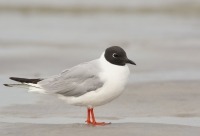
(Photo: Nathan Dubrow)
Bonaparte's Gull
Chroicocephalus philadelphia
A small gull, roughly 34 centimetres long and with a wingspan of 84 centimetres. Has white undersides and breast, slate grey upper wings and back, and black wing tips. Has bright red-orange legs and feet, and a small black bill. In the winter, the head and face are white. In breeding season, the head and face are black with white crescents above and below the eyes. Males and females look alike, although the males tend to be slightly heavier. They may live for up to 18 years.
Authority
Ord, 1815
Classification Details
Phylum: Chordata (chordates); Subphylum: Vertebrata (vertebrates); Class: Aves (birds).
Habitat
Widely distributed across North America, from Nova Scotia to British Columbia and from Alaska south to the Gulf of Mexico. It winters along the Atlantic, Pacific, and Gulf coasts and the Great Lakes. Found in ocean bays, coastal shores, and marshes around the Bay of Fundy, and in bogs, lakes, and rivers inland. Breeds in northwestern Canada and Alaska.
Diet
Along the coasts, where it spends most of the year, it feeds on small fish, crustaceans, insects, marine worms, and other invertebrates. Usually takes food from the surface of the water, feeding over tide channels and kelp beds. Occasionally dives, swims down for a few strokes and then glides back to the surface. When inland during the summer nesting season, feeds on insects taken from the air or the surface of lakes and rivers. Do not eat at dumps like many other gulls.
Reproduction
Breed in isolated pairs or small colonies, starting at two years of age. They build nests of sticks and moss in conifer trees near water, usually one to four metres above the ground. They lay two to four eggs per year, between May and July. Both parents care for the eggs and chicks. Eggs hatch after about 24 days. Chicks emerge from the eggs covered in down and open their eyes as soon as they are dry. They leave the nest after six to seven days. Adults are aggressive in defending their nests, willing to mob larger animals like hawks, ravens, and humans.
Fun Facts
The only gull that nests in trees.
Named after French emperor Napoleon Bonaparte's nephew, Charles Lucien Bonaparte, who was a famous ornithologist in America and Europe in the 1800s.
References
Audobon Bonaparte’s Gull. Guide to North American Birds. https://www.audubon.org/field-guide/bird/bonapartes-gull Accessed online 22 January 2020.
Burger J and Gochfeld M (2002) Bonaparte’s Gull (Chroicocephalus philadelphia), version 2.0. In The Birds of North America (A. F. Poole and F. B. Gill, Editors). Cornell Lab of Ornithology, Ithaca, NY, USA. https://doi.org/10.2173/bna.634 Accessed online 22 January 2020.
Park S (2001) Larus philadelphia (On–line), Animal Diversity Web. https://animaldiversity.org/accounts/Larus_philadelphia/ Accessed online 22 January 2020.
Vuilleumier F (2009) Birds of North America Eastern Region. New York: Dorling Kindersley. Wildlife Journal Junior. Bonaparte’s Gull – Larus philadelphia. https://nhpbs.org/wild/bonapartesgull.asp Accessed online 22 January 2020


